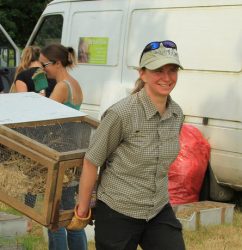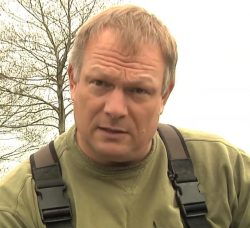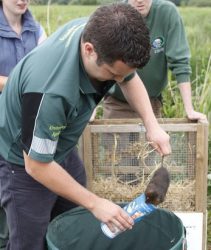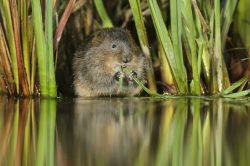Don’t go chasing water voles
August 2, 2017
 In 2013 the first water voles were released at Titchfield Haven as part of an ambitious project to reintroduce these locally-extinct animals to the River Meon. Five years and almost 2,500 water voles later we asked some of the people involved what the project has meant to them.
In 2013 the first water voles were released at Titchfield Haven as part of an ambitious project to reintroduce these locally-extinct animals to the River Meon. Five years and almost 2,500 water voles later we asked some of the people involved what the project has meant to them.
Once a common sight in the Meon Valley, water voles are thought to have become locally-extinct by 2008. We are pleased to say that the water voles are settling well into their new homes and the final release will take place on the Meon this August. Keep an eye on our SDNPA Facebook page for details of our Facebook Live broadcasts from the release site.
The plan to bring them back, all the way from the river’s source, along the length of the Meon Valley and to the coast, would be the largest scale water vole release ever attempted in the country. One that would need the support of landowners, river users and volunteers as well as the main project partners.
The landowners
“We live close to the head of the river and when we first moved here in 1969 it was full of water voles. It was very sad when the mink came and cleared the river of pretty much everything. It was lovely to hear that there was a plan to bring water voles back. We put mink rafts in about five years ago and I’ve been keeping an eye on them ever since.
“We had our first release this June with 59 water voles released into the river. The river has steep banks and lots of vegetation here but I’ve seen footprints and droppings. Long may they continue!”
Rosemary
“Around 130 water voles were released into our stretch of river in 2016. On most days I’ll hear a ‘plop’ as I walk our dog down by the river. I stumbled across one the other day; I’m not sure which of us was more surprised to see the other.”
Sally
 The National Park ranger
The National Park ranger
“This project ticks every box for why the South Downs became a National Park – bringing volunteers, landowners and the local community together to care for landscapes and support wildlife.
“I was asked to take on the water voles project in my first few months at the National Park. My first priority was to look at why they’d become extinct here, then prove that the mink were under control and look for potential water vole release sites. We started with organising and training the volunteers who have been so vital to the project.
“The Meon’s river system just didn’t function properly without water voles. Now it can.”
Elaina Whittaker-Slark, Project Manager and Lead Ranger for South Downs National Park Authority
 The volunteer
The volunteer
“I knew nothing about water voles when I volunteered for this project, but it sounded like a unique chance to participate in something very worthwhile – and enjoy myself in the process.
“Our training covered many aspects especially in how to identify the presence of water voles in the river, water safety training, their ideal river bank habitat and the importance of controlling mink, their main predator. We go out regularly to look for evidence of how the voles are doing – looking for their droppings, burrows, feeding “larders” etc. so we can see whether they’re around and breeding.
“I enjoy reporting back to the landowners once a year to discuss and feedback to them our views on the suitability of the habitat on their stretch of the river as well as any evidence we may have found on the presence of water voles.”
Nevill Brooke, South Downs Volunteer Ranger
 The Angler
The Angler
“The type of fishing we do on the river is not necessarily about catching fish – if that was all we cared about we’d go to a well-stocked lake. Our members fishing experience is enhanced by the natural environment around them.”
“I was first approached to see if we could help with monitoring for mink in preparation for the water vole reintroduction and so we started installing mink rafts on our beats, we then began to look at how we could best manage the habitat. We released the first voles on our patch in 2015 with more following in 2016.
“It has on occasion been a challenge to strike the right balance between conservation and the needs of our members, but on the whole the work has been well-received. I regularly get members contacting me to let me know they’ve spotted a water vole or heard the ‘plop’ of one dropping into the water.
“Our rivers are under huge pressures and angling is just one of the demands we place upon them. Being part of the water vole project has enabled us to take a wider look at how we manage these habitats for everyone.”
Matt Owen-Farmer is Environment Officer for Portsmouth Services Fly Fishing Association
The conservationist
“I’ve been working towards the return of water vole to the Meon Valley for nearly ten years, when we first started looking for funding to help with mink control.
“Once the project was underway I also helped train volunteers to carry out water vole surveys to detect any last-remaining voles (there were none…), and then to find suitable areas of habitat for releases to take place. The volunteers now survey for animals after release, to see how the populations are establishing, and I also get involved with the releases themselves.
“For us the water vole is a great way to get more people involved in caring for their river. It’s the difference between suggesting someone makes general improvements to a site or saying: if you do this then you’ll be able to see water voles here. It’s been great to work with the landowners and fishing clubs. Whether they remember seeing water voles here in the past or are new to the area, it really means something to them to see water voles now.
“But this is about so much more than just one species– if you make the river better for water vole, all the other wildlife benefits.”
Ali Morse, Hampshire and Isle of Wight Wildlife Trust
 The Environment Agency
The Environment Agency
“It’s been one of the best projects that I have worked on since joining the Environment Agency, so very rewarding, and it is great when people tell me that they have seen a Water vole on the Meon, or heard the classic “plop” of a Water vole entering the water.
“I have been very lucky and humbled by the dedication and commitment of those working on the project.”
Adam Cave is a Biodiversity Technical Specialist at the Environment Agency
The National Nature Reserve ranger/ volunteer
“As a teenager I remember seeing water voles along Titchfield Canal in the 1970’s. Twenty years later they were all gone. The project was a fantastic opportunity to see these endearing, iconic animals brought back into the local landscape.
“It has been very rewarding to be part of a project that has been so successful at delivering its aims and returning the water vole to Meon Valley. The fact that Titchfield Haven, as the initial release site, was the catalyst for this success makes all the more special.”
Richard Levett, former senior ranger with Hampshire County Council and current volunteer at Titchfield Haven
 The Meon Valley Water Vole project is a partnership between the South Downs National Park Authority, the Environment Agency, Natural England and the Hampshire and Isle of Wight Wildlife Trust.
The Meon Valley Water Vole project is a partnership between the South Downs National Park Authority, the Environment Agency, Natural England and the Hampshire and Isle of Wight Wildlife Trust.
